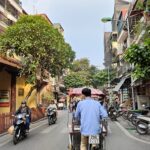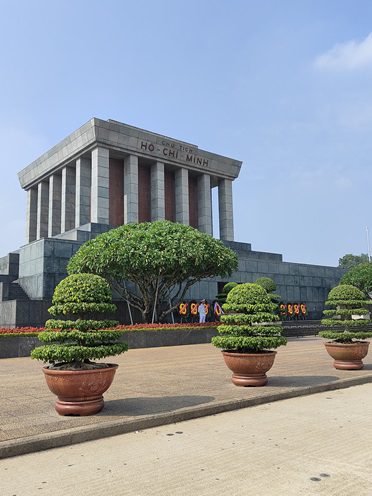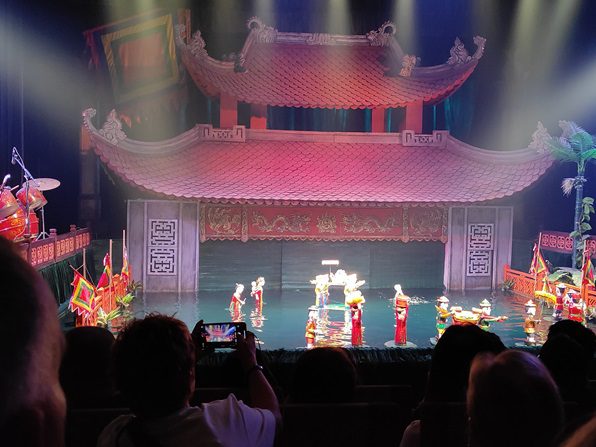 Vietnam’s capital, Hanoi, is ‘the’ place to experience all that is Vietnamese. A cultural city steeped in traditions has adapted to a modern lifestyle to cater to its growing tourist influx. Translated as ‘city inside rivers’, it is built on the lowlands between the Red and Nhue rivers. Traces of many rivers run around Hanoi and form lakes inside the city. The city has been a confluence of cultures from the North in China and the Champa Kingdom of the South that practised Hinduism.
Vietnam’s capital, Hanoi, is ‘the’ place to experience all that is Vietnamese. A cultural city steeped in traditions has adapted to a modern lifestyle to cater to its growing tourist influx. Translated as ‘city inside rivers’, it is built on the lowlands between the Red and Nhue rivers. Traces of many rivers run around Hanoi and form lakes inside the city. The city has been a confluence of cultures from the North in China and the Champa Kingdom of the South that practised Hinduism.
I started my tour of Hanoi with a visit to the Temple of Literature, Vietnam’s first University. It was founded in 1070 by an emperor as a temple to worship the Chinese philosopher Confucius and host an imperial academy. ‘Van Mieu, ‘ which means Temple of Literature, is an impressive historical and cultural landmark of Vietnam. Classes are no longer held here, but they get many visitors like me, making it a key attraction in Hanoi.
The heritage entrance was welcoming enough to explore further. With five different quarters set amidst landscaped gardens, Serene Place opened onto three pathways that continued through the complex. I walked through the centre path that was earlier reserved for the monarch. There is a giant bronze bell with several patterns, including a dragon. Guide said it was used during the olden days to announce the arrival of an important person. The path to the left was for the administrative personnel, and the right was reserved for military personnel. There are a total of five courtyards spread over an expansive landscape. The first two courtyards, with age-old trees lining the garden’s lawns, were supposedly relaxing places for the scholars. Some bushes here are aesthetically shaped to represent 12 zodiac symbols.

Captivating the Khue Van pavilion at the entry to the second courtyard, or a courtyard of success, has also been adopted as the symbol of Hanoi. Poetic phrases depicting traditional culture are preserved at the pavilion. A square pond in the third courtyard has beautiful flower plants lining it. On either side are halls that house treasures of the temple. 82 stone stelae of carved blue stone turtle motifs depict the names and birthplaces of 1307 graduates of 82 triennial royal exams. The turtle is one of the four holy symbols of Vietnam and represents wisdom and longevity. This central sector of the Imperial Citadel of Thang Long is recognised as a UNESCO World Heritage Site for its stone stelae. They reflect a unique Southeast Asian culture specific to the lower Red River Valley, at the crossroads between influences from China in the north and the ancient Kingdom of Champa from India in the South.
The temple of Confucious, built in traditional architecture, is located south of the Imperial Citadel. The temple is also featured on the back of the 100,000 Vietnamese Dong banknote. There are also alters befitting the worship of knowledge. Offerings of fresh fruits and flowers make it a lively place. The place also comes alive just before the Tet Vietnamese New Year Celebration when calligraphists assemble outside the temple and write wishes later given away as gifts to visitors.
The Ho Chi Minh Mausoleum, part of the mega-complex, is not far away from Van Mieu. President Ho Chi Minh is a revered hero in Vietnam. The City of Saigon, the commercial capital of Vietnam, is renamed after the hero. The complex has a stilt house where Ho Chi Minh lived before independence. President Ho Chi Minh, or Uncle Ho, as he was fondly known, had read the Declaration of Independence at this very place on 2 September 1945. Entry is free and makes for a relaxed walk in the vast complex. Baggage had to be deposited at the entrance of the mausoleum. Decent attire is advised to be worn to enter the shrine complex. One has to get there early in the day as it closes by 11.30 am. There is a presidential palace and an interesting structure of a one-pillar pagoda within the complex. Outside, on the vast open grounds, is the mega, grey granite chamber that enshrines the body of President Ho Chi Minh. It has white uniformed guards and is surrounded by beautifully maintained gardens. Independence Day and other official parades and celebrations occur at the big open square in front of it. The imposing Vietnam National Assembly building is just across the street.
After learning about the scholarly and patriotic heroes of Vietnam, it was time to explore the lifestyle of the Vietnamese. Hanoi Old Quarters, the most popular district for locals and tourists alike, is a vibrant place with many sights and hues. It’s a place you can’t or would want to visit again and again. This live cultural hub is declared a UNESCO WORLD Heritage Site as a well-preserved example of a Southeast Asian trading port of the 15th and 19th centuries, with buildings that blend local and foreign influences.
One can walk around, cycle on a hired bike or take a bike taxi to a particular street. The popular touristy way is to take the Cyclo or the battery-operated buggy van. Hanoi’s old quarter is a lively cultural hub in the heart of the capital city. Located in Hoan Kiem District, which also has the lake by the name Hoan Kiem, it is supposed to have 36 streets. I lost count of mine as I got engrossed in the place’s vibes while riding on a royal Cyclo trip. An hour-long ride on the Cyclo offered a peek into the unique blend of traditional and modern influences as it passed the maze-like alleys. It was a feast of window shopping through different products like flowers, fruits, furnishings, pots, metal items, hats, art work, shoes, textiles, furniture, furnishings, massage parlors and restaurants. Dotted residences in between featured a beautiful blend of Vietnamese, Chinese and French architecture, ceramic roof tiles being the key differentiating factor. Each street is dedicated to selling a particular product. Cafés, hotels, spas and shops selling junkets have replaced some shops, making it convenient for tourists to stay in the quarters to enjoy local vibrancy.
Ladies with traditional hats on their stationed bicycle carts sold seasonal flowers and local fruits like oranges, Cu San (Jicama) and guavas. While I was just being transported to a different era, a modern café or a fantastic art gallery brought me back to current times. It’s probably this fine blend that has made Vietnam the new tourist hotspot in Southeast Asia.
Crowds had already gathered at the Thing Long Water Puppet Theatre for the early evening show when the Cyclo dropped me at the busy square. The show, based on the traditional art played after rice harvest from paddy fields, has gained worldwide popularity. Thanks to its permanent continuous shows here at the banks of ancient Sword Lake, now known as Hoan Kiem Lake. The theatre in the prime location was converted from an existing Hoa Binh Cinema in 1993. The Water Puppet Show is featured among the top sights of Hanoi. The seating in the lobby was packed, and people waited outside in groups.
There are multiple shows every day, and tickets can be booked online. The show started with a melodious musical rendition by the supporting orchestra team. The colourful dragon emerged from the water below next to a lot of crowd cheer and moved across the arena with a Pagoda as its backdrop. The technology of water puppetry is a thousand-year-old art form of Northern Vietnam. It was played to celebrate the end of rice harvesting, mark festivals, and entertain royals. Vietnamese orchestra of bamboo, flutes, drums and bells played along to present the well-supported, amusing and entertaining show. It offered fascinating insights into Vietnamese peasants’ and fishermen’s lifestyles in earlier times when rice paddy, ponds, or rivers formed the stage. The 50-minute show has 15 water puppets performing dances, folktales, and legends.
Puppets weighing up to 15 kg and standing two feet high in water are manoeuvred across the water’s surface via a system of underwater poles, rods and strings. Heavier ones require two to 3 puppeteers standing in waist-deep water behind the screen to manoeuvre. The puppetry troupe has also travelled to different cities worldwide to perform. Later, I learned that the theatre is associated with the Hanoi University of Theatre and Cinema in encouraging and training young artists to continue the rare, indigenous art.
Café culture is extensive in Vietnam, be it from street-side carts or high-end cafes, thanks to the country’s rich coffee cultivation. The coffee experience at Hanoi Train Street after a sumptuous Indian meal at Tadka is etched in my memory. I was spoilt for choice with so many cafes by the track. There are homes alongside the train track, and they have smartly converted portions of their homes into artistically decorated cafes with colourful lanterns hanging out. As I sipped my coffee, engrossed in the atmosphere unique to Hanoi, the siren went off. Volunteers stepped out in no time to move people away from the track and asked us to stay close to the walls. The train emerged, and seeing it pass by at an arms-length was exciting. Staying nearer to the train track street at Silk Path Hotel made it convenient for me to visit the train track at the time of the passing train. The four-star hotel has beautiful modern rooms and a good breakfast selection and is close to Hanoi Old Quarters.
Vietnam, the country that runs along the coast of the South China Sea, has diverse landscapes with beaches, mountains, rivers and deltas. Hanoi is the gateway to Halong Bay, the UNESCO World Heritage site with vast chambers of fantastic stalactite and stalagmite formations, islands, islets, mountains and the ocean.
Written by Madhura Katti

